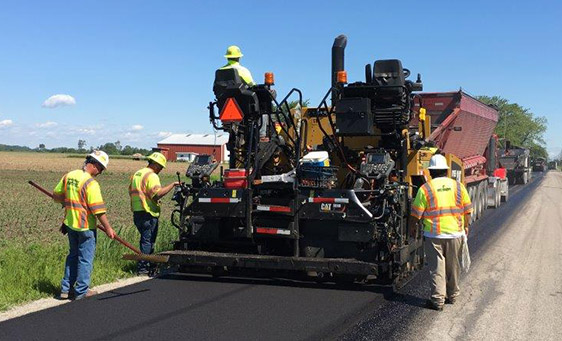Reimagine Your Area: Hot Mix Asphalt Paving for Angled Parking Lot Jobs
Reimagine Your Area: Hot Mix Asphalt Paving for Angled Parking Lot Jobs
Blog Article
Opening the Tricks of Warm Mix Asphalt Innovation
Discovering the depths of warm mix asphalt modern technology uncovers a globe where meticulous procedures and precise formulations merge to shape our roads and facilities. The fusion of fillers, accumulations, and binders isn't just a construction task however a critical orchestration of resilience and performance. As we peer into the detailed dance of parts, a tapestry of resilience and sustainability unfolds. What lies beneath this surface area of asphaltic mastery, and what tricks wait to be unveiled in the realm of leading advancements?
Significance of Warm Mix Asphalt
Warm Mix Asphalt plays a crucial function in modern-day facilities development because of its toughness and cost-effectiveness. As the most typically utilized paving material for roads, highways, and parking lots, Hot Mix Asphalt offers a variety of advantages that add to its value in construction jobs. One essential advantage is its capacity to hold up against rush hour lots and severe weather conditions, providing a resilient and trusted surface area for transport networks. Furthermore, Warm Mix Asphalt is cost-efficient in both first construction and lasting upkeep, making it a favored choice for lots of facilities tasks.
The resilience of Warm Mix Asphalt stems from its make-up, which consists of aggregates, binder, and filler materials that are very carefully picked and blended to satisfy details performance demands. Generally, the importance of Hot Mix Asphalt in infrastructure advancement can not be understated, as it proceeds to be a cornerstone of modern building techniques.
Elements of Asphalt Mixes
The make-up of asphalt mixes is composed of meticulously selected accumulations, binder, and filler materials that are essential for accomplishing certain performance needs. Accumulations are the key component of asphalt mixes, providing toughness and security. The binder, usually bitumen or asphalt cement, holds the accumulations together and gives adaptability and longevity to the mix.
The mix and percentage of these parts play a significant function in figuring out the high quality and efficiency of the asphalt mix. Engineers meticulously design the mix to satisfy particular demands, thinking about aspects like website traffic volume, climate conditions, and sidewalk life expectancy. Proper selection and harmonizing of aggregates, binder, and fillers are vital for developing resilient, long-lasting asphalt sidewalks.
Mixing and Manufacturing Methods

When the aggregates are chosen, the binder, commonly asphalt concrete, is contributed to bind the materials together. The binder's quality and amount significantly influence the mix's strength, resistance, and flexibility to ecological elements. In addition, fillers read the article like moisturized lime or Portland concrete may be included to improve details features of the asphalt mix, such as its workability or moisture resistance.
During manufacturing, the aggregates and binder are heated up, commonly between 250-325 ° F(121-163 ° C ), to facilitate blending and make sure correct covering of the accumulations. The blending procedure should be thorough to achieve an uniform blend that promotes the desired efficiency qualities of the asphalt. Various strategies, such as batch blending or drum blending, are employed to attain constant and top quality asphalt mixes for building and construction jobs.
Factors Influencing Asphalt Performance
Factors affecting asphalt efficiency include a range of variables that affect the resilience, long life, and general top quality of asphalt pavements. One vital element is the top quality of materials made use of in the asphalt mix. The type and resource of accumulations, the binder high quality, and the ingredients all play a significant duty in determining the efficiency of the asphalt sidewalk. The gradation of accumulations is crucial as it impacts the mix's resistance, workability, and stability to splitting and rutting.

Environmental problems also affect asphalt performance. Temperature level variations, wetness seepage, and traffic lots can all impact the architectural integrity find more of the sidewalk. Layout considerations, such as sidewalk thickness and drain, are crucial in making sure the lasting performance of the asphalt pavement. news By meticulously considering these designers, variables and professionals can enhance asphalt efficiency and boost the life span of pavements.
Sustainable Practices in Asphalt Technology

WMA permits for the production and positioning of asphalt blends at lower temperature levels compared to standard hot-mix asphalt, resulting in reduced energy intake and greenhouse gas emissions. The usage of permeable asphalt mixes can assist mitigate stormwater overflow concerns by allowing water to penetrate via the pavement and into the ground, advertising all-natural water filtration and charge procedures.
Conclusion
To conclude, hot mix asphalt innovation plays a vital duty in modern infrastructure development due to its sturdiness and cost-effectiveness. By very carefully stabilizing parts, using correct blending strategies, and taking into consideration numerous variables, designers can develop high-quality asphalt blends that withstand rush hour lots and rough climate condition. Accepting sustainable methods, such as using recycled materials and warm-mix technologies, better improves the environmental friendliness of asphalt technology.
Blending and manufacturing techniques in hot mix asphalt modern technology include the accurate combination and handling of accumulations, binder, and fillers to create a durable and high-performance asphalt mix.Variables influencing asphalt performance incorporate a variety of variables that impact the durability, long life, and general quality of asphalt sidewalks. Sustainable techniques in asphalt innovation encompass numerous efforts aimed at lowering the environmental influence of asphalt production and paving processes. By integrating reclaimed asphalt sidewalk (RAP) and recycled asphalt shingles (RAS) right into brand-new asphalt blends, the industry can dramatically decrease the intake of raw materials and power, while also lowering land fill waste.
WMA allows for the manufacturing and placement of asphalt mixes at reduced temperature levels contrasted to conventional hot-mix asphalt, resulting in lowered power intake and greenhouse gas discharges.
Report this page